From a theoretical viewpoint, zeta potentials is the electric potential in the interfacial double layer at the location of the slipping plane relative to a point in the bulk fluid away from the interface. Wikipedia 2.Zeta potential and vancomycin-red blood cells interactions
On sustained injuries which rips the skin open, the blood which gushed out of the vessels due to trauma turns into clumps and dries off within a short while, intentionally withdrawn blood filled in a plain tube (tube without anticoagulants) forms a lucid clump after a while, unarguably One would begin to wonder why these actions do not take place intravascular in a normal being.
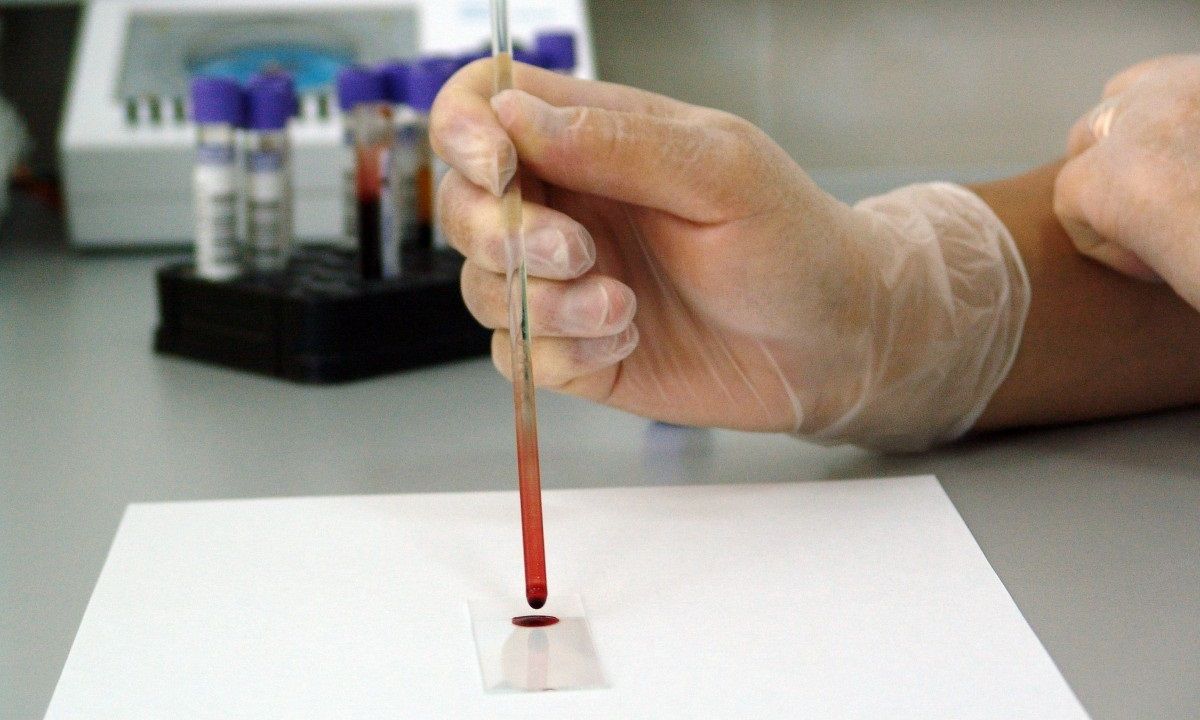
credit: pxhere. CC0 creative commons license. Unknown author
The interesting features of the blood, the vessels and other associated parts of the circulatory system which keeps the blood in a fluid state throughout its stay inside the vessels and the external changes which makes it clot when it leaves this environment has puzzled scientists over the years and also the component of the circulatory system which plays the highest role in this amazing feature have also been a matter of scientific speculations and researches. Fortunately, scientific advancements and continued discoveries in this field have given an insight on this; let’s find out…
Understanding the concept of blood coagulation/clotting
Blood clotting is more of a biochemical reaction than the simplified physical reaction we see without the microscope, and much role is played by the fluid and cellular components of the blood. The antibodies formed by the plasma proteins binds to the antigenic sites of the red blood cells, a very reasonable interaction also occurs between the surrounding red blood cells and this presents external as a pack of blood corpuscles with an expelled straw coloured fluid which contains mainly proteins and water, in a trauma which ripped the skin open, this component of the blood comes off dried and separates from the visible clot formed in the area of the injury.
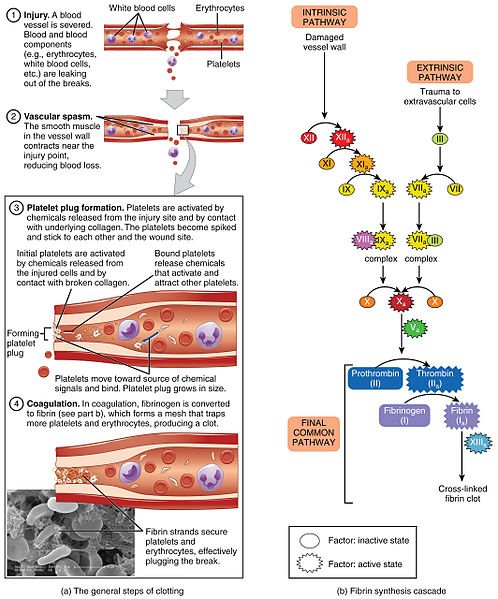
Blood clothing process. Credit: wikimedia CC3.0 license. Author: GrahamColm
The blood coagulation is composed of a series of functionally specific plasma proteins reffered to as coagulation factors these are denoted with Roman numerals in order of their or discovery, these coagulation factors interact in a highly ordered and controlled cascade, resulting in the formation of an insoluble fibrin mesh which strengthens and stabilizes the primary haemostatic plug formed by the platelets in an attempt to restore the integrity of the blood vessels, a number these clotting factors are zymogens and are only activated by the processes of trauma and damage to the to the blood vessels, most other blood coagulation factors are serine proteases, containing serine residues in its active enzyme site, the labile factor and the anti-haemophilic factors are accelerators of blood coagulation and acts as catalyst for other enzyme reactions associated with normal blood coagulation.
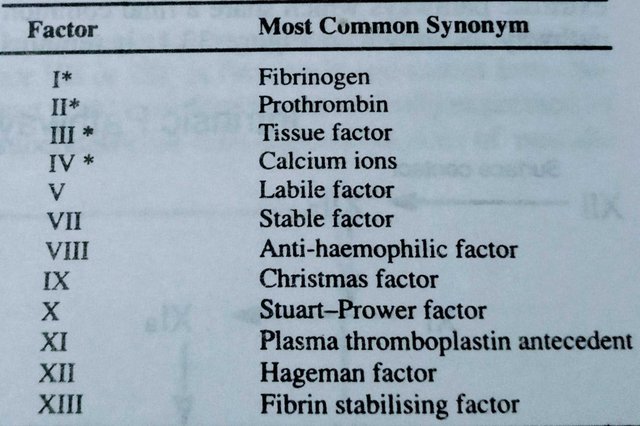
Blood coagulation factorss. Credit: picture taken by me. Author: @joelagbo
The intrinsic blood coagulation pathway have been accepted over the years and have attempted to explain blood coagulation as being triggered by the release of plasma thromboplastin antecedent (factorXI) and the Hageman factor(factorXII) by blood which comes in contact with a negatively charged foreign surface such the basement membranes, collagen or bacterial lipopolysaccharide, this reaction activates these coagulation factors and results in a cascade of events which involves the activation of other blood coagulation factors and a resultant formation of a fibrin mesh from the precursor fibrinogen which augments the plug formed by the platelets to cover up the traumatised vessels.
However, with the relatively recent discovery of the tissue factor pathway inhibitor (TFPI) together the need to explain the lack of bleeding tendency in individuals deficient of the Hageman factor and also the severe bleeding tendency in haemophiliacs have given rise to a more acceptable scheme of coagulation which purely showcases the roles played by the traumatised blood vessels and the blood itself.
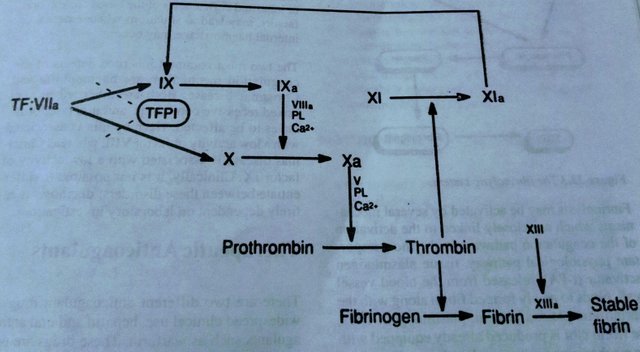
The revised and accepted blood clotting cascade. Credit: picture taken by me. Author: @joelagbo
The subendothelial cells of the damaged blood vessels releases tissue factors on it surface, the flowing blood comes in contact with these expressed tissue factors, binding of inactive stable blood coagulation factor(factorVII) to these exposed tissue factors activates it and forms a complex with the activating tissue factor, this complex activates the Stuart factor (factor X), further production of the activated Stuart factor is blocked by the Tissue factor pathway inhibitor (TFPI) , however further production of the Stuart factor is made possible by the Christmas factor. The activated Stuart factor via the tenase reaction activates prothrombin (activated prothrombin is known as thrombin). the tenase reaction is catalysed by anti-haemophilic factor, calcium and phospholipids, phospholipids acts to localise clotting and prevent dispersed intravascular coagulation. The produced thrombin converts fibrinogen to fibrin, the fibrin is an unstable soluble clump of proteins and is stabilised by fibrin stabilising factor(factorXII) a transglutaminase.
Blood withdraw from the vessels via controlled means for medical purposes also follows this cascade as the contact with the tissue factors from the pierced vessels is already made and coagulation continues in the plain tube, addition of anti-coagulants prevents coagulation by cheating calcium, this the prothrombinase and tenase reactions are blocked, this prevents the production of thrombin and the subsequent conversion of fibrinogen to fibrin.
These reactions never takes place intravascular in a normal person, this is not only due to the absence of injuries due to trauma but also due to several other control measures in which the blood, proteins and the vessels plays the major roles.
Role played by the blood cells in fluidity of intravascular blood
Zeta potential and the theory of electronegativity in Red blood cells membrane
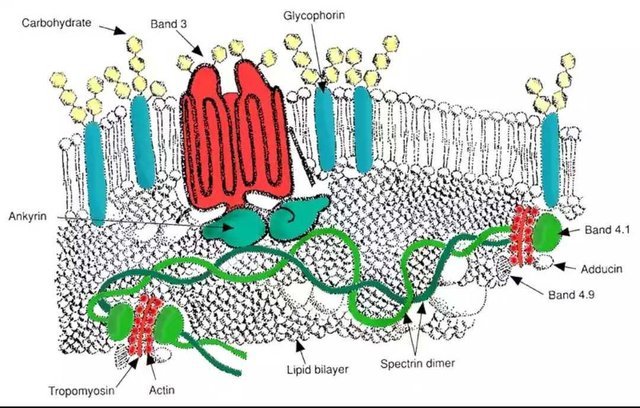
structure of Red blood cells membrane. Credit: wikimedia CC3.0 license. Author:
Red blood cells do not aggregate in the blood stream, this would have been very fatal and such defects are only seen in severe pathological cases, the viscoelastic membrane of the Red blood cells contains four structural proteins, Actin, Ankyrin, protein4.1, and *Spectrin(α and β), these proteins makes up about 50% of the red blood cell membrane, these proteins are bound to integral transmembrane glycoprotein, Glycophorins A,B,C. These proteins and glycoproteins are embedded to fluid lipid bilayer, the lipid bilayer determines the fluidity of the of the red blood cells membrane while the bound proteins and glycoproteins are responsible for the flexibility of the red blood cells membrane carbohydrates are also found in the external surface blood cells membrane and makes up 10% of the red blood cells membrane, they only occur externally.
The glycoproteins and protein bound to the fluid lipid layer are negatively charged and creates a repulsive electric potential between the blood cells and this prevents their aggregation in the blood stream, this electric potential is known as Zeta potentials. This is also due to ionisation of the carboxyl group of the N-acetylneuraminic acid (NANA/sialic acid) in the cell membranes
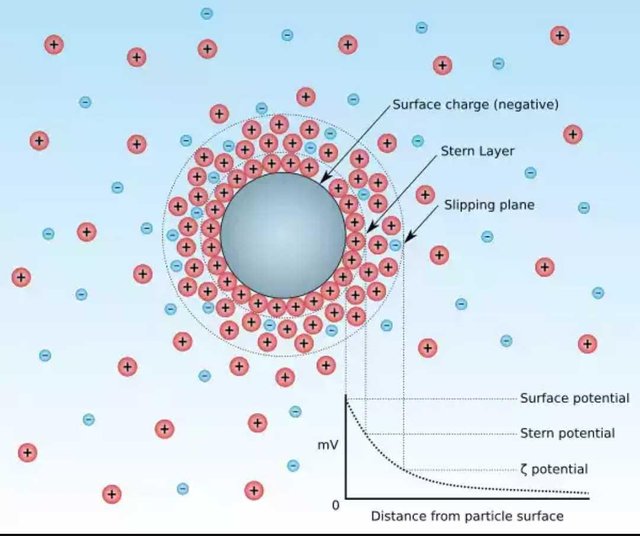
zeta potentials in particles dispersed in a liquid medium. Credit: wikimedia CC3.0 license. Author:
Zeta potentials is the potential difference between a dispersion medium and the stationary layer of the fluid attached to the dispersed in the fluid medium, it is measured in microvolts(mV) , intravascular, the blood is a suspension of cells in a fluid medium–the plasma, this potential difference exists between the blood cells and the plasma due to the negative charges created by the membrane proteins and glycoproteins culminating in a weak repulsive force between the dispersed cells. Extravascular, in laboratory researches, the zeta potentials also explains in a bit why red blood cells suspended in saline repels each other, this weak repulsive force prevents agglutination of the red blood cells by small immunoglobulin G(IgG) hence the red blood cells stay apart in the presence of light-strength contrasting antibodies, this ensures that only high-power agglutinins causes agglutination of the blood cells while still in the body.
The magnitude of the zeta potentials determines the stability of the colloidal dispersion, it indicates the degree of electrostatic repulsion between adjacent similarly charged particles in dispersion, small zeta potentials are easily over-powered by attractive forces and the repulsion might not be sustainable if the zeta potentials is not strong enough the zeta potential is directly proportional to the electrical stability of dispersed colloids. In haematological study of the blood, blood cells are the colloids dispersed in the plasma and hence obeys this theory, a zeta potential below 5mV allows rapid coagulation, however the speed of coagulation reduces with increasing zeta potentials, at 60mV zeta potential, coagulation rarely/never occurs. Vancomycin is found to reduce the zeta potential between the blood cells and the dispersion medium and hence is used to induce agglutination in haematological researches.
Zeta potential keeps the red blood cells apart and prevents agglutination by weak attractive forces, in addition to the zeta potential’s effect, the blood vessels also plays a role in keeping the intravascular blood in a fluid state.
Haemodynamics in haemostasis and the roles played by the blood vessels and blood flow in maintaining fluidity in intravascular blood circulation
Haemodynamics: The principles of motion of fluid moving in restrictions and the velocity of flow plays an important role in the maintenance on fluidity of blood in the vessels, turbulent flows are characterized by fashion tree flow of fluid in an unorganized manner fluid in turbulent flow moves at a high velocity and due to its unorganized flow, there’s much friction between the flowing fluid and the walls of the restriction.
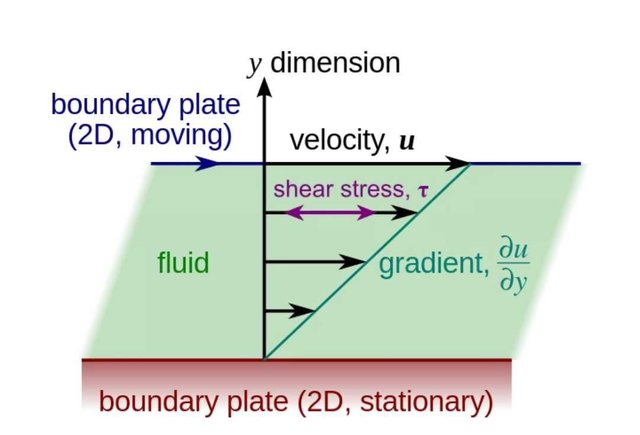
illustration of laminar shear of fluid moving between two plates,this also applies to blood moving inside the vessels. Credit: wikimedia CC3.0 license. Author:
Blood flow is no stranger to this and the principle of haemodynamics corresponds to the mechanics of flow of any other fluid. Blood in the vessel flows in a laminar pattern and hence only little friction exists between the flowing blood and the blood vessels. In a turbulent flow, the blood hits the intima of the vessels with a force strong enough to traumatize these vessels leading to the release of Tissue factor, which is the onset of coagulation, this is only seen in pathological situations and results in the formation of thrombi, coagulation continues in little pieces culminating in the production of very tiny blood clots which disseminates throughout the body, this is known as Disseminated Intravascular clotting. This situation is averted in a normal flowing blood as blood in the vessels flows in a laminar pattern.
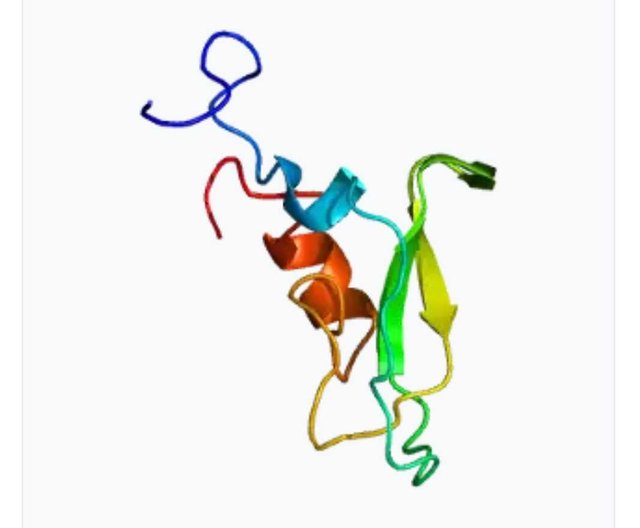
structure of Tissue factor pathway inhibitor. Credit: wikimedia CC3.0 license. Author:
Tissue Factor Pathway Inhibitor and texture of the blood vessels: If external coagulation isn’t curbed by inhibiting the production of the Tissue Factors, coagulation in case of trauma to the vessels would definitely spread to the internal blood in a concentration big enough to cause intravascular coagulation, the tissue factor pathway inhibitor produced in the endothelial cells and also in the plasma and platelets swings in to tame the effect of the Tissue factor and labile factor complex by counteracting the production of more tissue factors from the blood vessels by accumulating at the site of injury and inhibits the production of labile factors and Stuart factors. Elsewhere, the intima of the blood vessels are smooth, this works in synergism with the laminar flow of blood in the vessels to ensure the absence of friction in the blood flow, all these actions works towards preventing the release of tissue factors and avoiding excess release of tissue factors in a bid to ensure that coagulation doesn’t take place intravascular. The endothelial cells also produces prostacyclin which opposes the vasoconstrictor effect of thromboxane A2 and the aggregation of platelets. Via these actions the blood in the vessels are maintained in a fluid state.
Off the vessels; what now?
The blood vessels must be traumatized before the blood will be able to leave the vessels, either by a planned perforation of the vessels using syringes or needles or by physical accidents which rips the skin and vessels open, the trauma which rips the vessels open is also capable of triggering the release of tissue factors and hence coagulation starts off. Filling the blood in a plain tube without anticoagulants allows this already triggered coagulation to continue, however, known the presence of anticoagulants the role played by calcium in blood coagulation is halted as calcium is chelated, hence the prothrombinase and tenase reactions are subdued and the blood remains in fluid state, due to the zeta potentials and the absence of an attractive force strong enough to overpower it, the red blood cells also stays apart and the blood continues to remain in a fluid state outside the vessels.
In the absence of these external measures, the blood clots after a short while with the blood cells separating from the serum which appears straw coloured and devoid of fibrinogen.
References
3zeta potentials
Due to unsatisfactory pictures over the internet, some pictures were taken from: textbook of medical laboratory technology by F.J Baker, R.E Silverton and C.J pallister (seventh edition)
If you write STEM (Science, Technology, Engineering, and Mathematics) related posts, consider joining #steemSTEM on steemit chat or discord here. If you are from Nigeria, you may want to include the #stemng tag in your post. You can visit this blog by @stemng for more details. You can also check this blog post by @steemstem here and this guidelines here for help on how to be a member of @steemstem. Please also check this blog post from @steemstem on proper use of images devoid of copyright issues here.
Authors get paid when people like you upvote their post.
If you enjoyed what you read here, create your account today and start earning FREE STEEM!
If you enjoyed what you read here, create your account today and start earning FREE STEEM!
no idea you were on steemit. Get double the votes now ;)
Downvoting a post can decrease pending rewards and make it less visible. Common reasons:
Submit
Yeah, been here for over half a year, thanks for coming around
Downvoting a post can decrease pending rewards and make it less visible. Common reasons:
Submit
Hello! I find your post valuable for the wafrica community! Thanks for the great post! We encourage and support quality contents and projects from the West African region.
Do you have a suggestion, concern or want to appear as a guest author on WAfrica, join our discord server and discuss with a member of our curation team.
Don't forget to join us every Sunday by 20:30GMT for our Sunday WAFRO party on our discord channel. Thank you.
Downvoting a post can decrease pending rewards and make it less visible. Common reasons:
Submit
Amazing post my friend!!
Downvoting a post can decrease pending rewards and make it less visible. Common reasons:
Submit
Thanks, I appreciate your kind gestures
Downvoting a post can decrease pending rewards and make it less visible. Common reasons:
Submit
I hope you don't mind, I purchased a boost for this post.
To me this is the best thing about the bid-bots, I can give worthy posts a boost!!
Not for myself, but for others.
Downvoting a post can decrease pending rewards and make it less visible. Common reasons:
Submit
Oh, my! This is kindest gesture I've gotten on steemit till date, thanks a million
Downvoting a post can decrease pending rewards and make it less visible. Common reasons:
Submit
the future doctor is in the house:)
Downvoting a post can decrease pending rewards and make it less visible. Common reasons:
Submit
Lol, thanks for stopping by, I really appreciate
Downvoting a post can decrease pending rewards and make it less visible. Common reasons:
Submit
Super post! Incredible amount of information, but at the same time broken down where it is understandable. Resteemed!
Downvoting a post can decrease pending rewards and make it less visible. Common reasons:
Submit
Thanks a lot, this means a lot to me
Downvoting a post can decrease pending rewards and make it less visible. Common reasons:
Submit
My pleasure!
Downvoting a post can decrease pending rewards and make it less visible. Common reasons:
Submit
Gratefulvibes trail upvote!!
Downvoting a post can decrease pending rewards and make it less visible. Common reasons:
Submit
Hi @joelagbo!
Your post was upvoted by utopian.io in cooperation with @steemstem - supporting knowledge, innovation and technological advancement on the Steem Blockchain.
Contribute to Open Source with utopian.io
Learn how to contribute on our website and join the new open source economy.
Want to chat? Join the Utopian Community on Discord https://discord.gg/h52nFrV
Downvoting a post can decrease pending rewards and make it less visible. Common reasons:
Submit
Thanks for using eSteem!
Your post has been voted as a part of eSteem encouragement program. Keep up the good work! Install Android, iOS Mobile app or Windows, Mac, Linux Surfer app, if you haven't already!
Learn more: https://esteem.app
Join our discord: https://discord.gg/8eHupPq
Downvoting a post can decrease pending rewards and make it less visible. Common reasons:
Submit